Обещая полет человека на Марс, ученые обсуждают технологическую и гуманитарную стороны этой перспективы. О проблемах же, связанных со здоровьем космонавтов в длительном полете, говорят меньше. Хотя, это, вероятно, самое главное, о чем необходимо беспокоиться, планируя марсианскую миссию. Вопросами такого рода занимается наука по имени космическая медицина.
Здоровье в полете
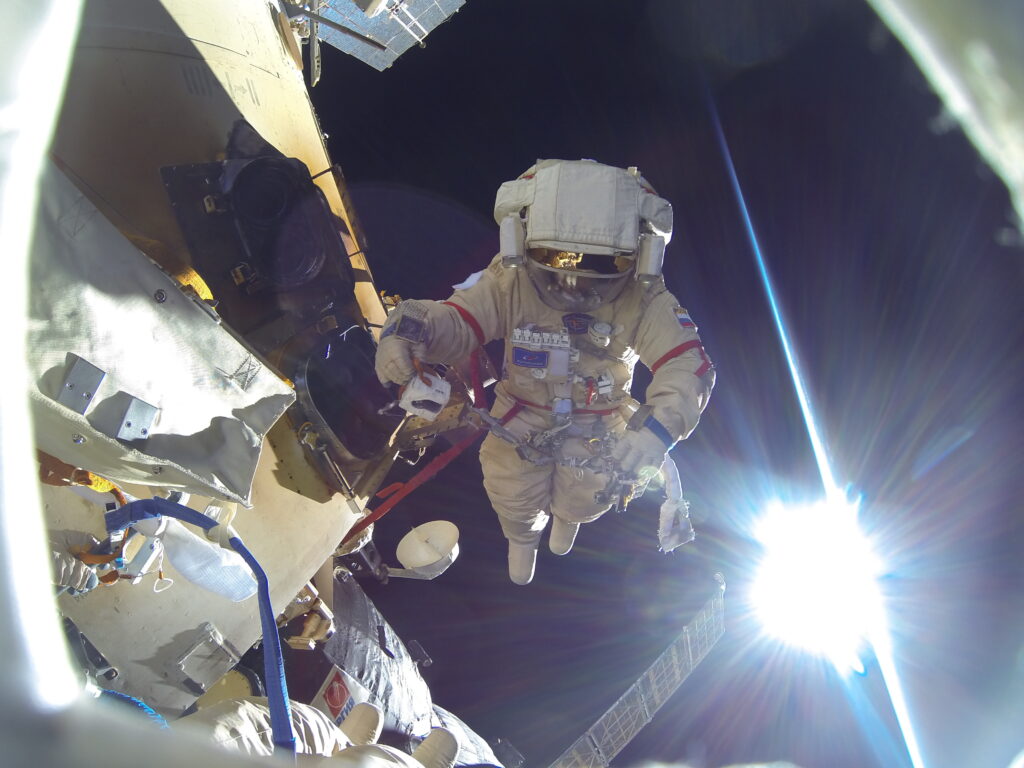
Spacewalk. Фото: космонавт Роскосмоса Сергей Кудь-Сверчков.
Космическая медицина изучает возможности поддержания здоровья, обеспечения жизнедеятельности человека в экстремальных условиях космического пространства и потенциальные проблемы на этом пути. Согласно модели SHELL, предложенной в 1970–80-х годах Фрэнком Хокинсом и Элвином Эдвардсом, в космосе человек приспосабливается и взаимодействует со следующими факторами, влияющими в различной мере на его здоровье: фактор Software (особенности поведения на борту космического корабля), фактор Hardware (сам корабль), Environment (среда на корабле: невесомость, воздух, температура, влажность и другое), Liveware (поведение человека в космосе) и Liveware (взаимодействие с другими людьми).
Selection criteria
Космическим полетом принято считать любой полет выше 100 км над уровнем моря. По типу полетов их принято различать следующим образом. Суборбитальные экспедиции, длящиеся несколько часов, где человек находится под воздействием гравитации несколько минут. Пребывание на малой орбите Земли (200–400 км над уровнем моря — например, МКС. И, наконец, дальние космические экспедиции (полеты на Луну, Марс и другие планеты).
В зависимости от типа полета человек будет подвергаться различным неблагоприятным для здоровья воздействиям (перегрузки, невесомость, радиация), которые могут по-разному влиять на его здоровье. Поэтому существуют строгие критерии отбора астронавтов, чтобы не допустить в космос людей с такими заболеваниями, которые могут обостриться во время экспедиции.
Основные критерии отбора в таком случае:
1) отсутствие болезней, приводящих к временной недееспособности (коронарная болезнь сердца, камни в почках, эпилепсия);
2) возможность участвовать в экспедициях разного формата (например, наличие астмы может затруднить нахождение в открытом космосе и атмосфере других планет);
3) отсутствие хронических заболеваний, которые требуют длительного приема различных медикаментов и осмотра врачей, которые, разумеется, невозможны в космосе.
Тем не менее при отборе космических туристов на суборбитальные полеты применяются менее строгие критерии. Например, в 2005 году 60-летний мужчина с легочными и сердечными нарушениями успешно перенес полет в суборбитальном пространстве. А 23-летний пациент с наследственным пороком сердца смог перенести перегрузку в 6g без особых последствий.
Подобные данные позволяют надеяться на скорое развитие массового космического туризма.
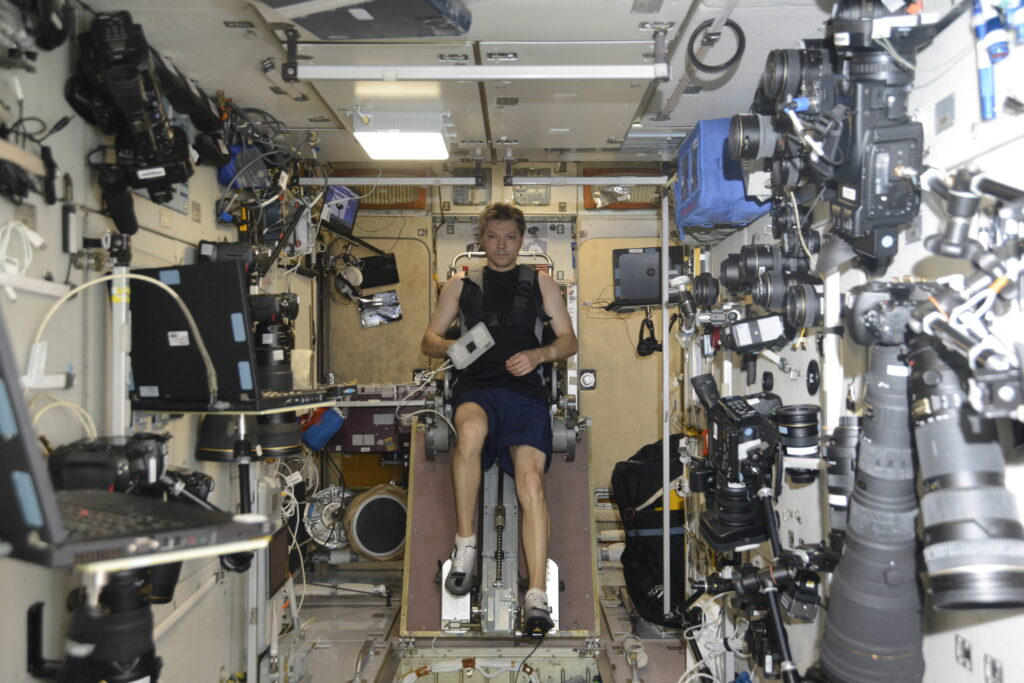
Training on a bicycle ergometer Photo by Oleg Kononenko. Source: Roscosmos
Negative impact
So what are the negative effects of a person in space?
First of all, it is weightlessness. According to various data, from 60 to 80% of astronauts experience the following symptoms associated with adaptation to space flight: nausea, vomiting, cough, and paleness of the skin.
Other important health disorders include the outflow of water from the lower extremities towards the head of astronauts under weightless conditions. These disorders lead to swelling of the head and face and the appearance of the “chicken feet symptom”. If no preventive measures are taken, then the vessels of the lower extremities, which detrain during the flight, will not be able to cope with the volume of blood entering them after landing.
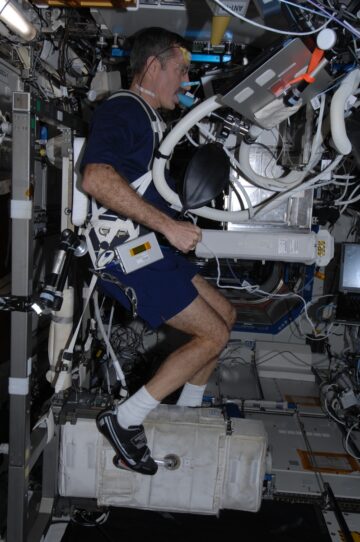
Experiment VO2MAX: determination of the body's performance during physical exertion in microgravity. Source: Roscosmos
A longer stay in space (the longest so far achieved is 485 days) could lead to much more serious health problems. Two factors usually lead to significant consequences: radiation and a long stay in a state of weightlessness.
In space, a person is exposed to huge doses of cosmic radiation, which can cause many disturbances in the functioning of the body.
On Earth, the atmosphere protects us from cosmic radiation, but in space the human body is directly affected by solar radiation, galactic radiation, radiation in the form of free protons and electrons.
However, even at low-orbit distances, the Earth's magnetic field reliably protects against cosmic radiation. Nevertheless, this magnetic field led to the formation of the Van Allen radiation belt, which attracts and holds charged cosmic particles in our magnetosphere. They directly affect astronauts in orbit.
Outside the Earth's atmosphere, cosmic radiation can damage DNA, damage the immune system, and cause cancer. At the moment, the maximum amount of radiation a 45-year-old astronaut can be exposed to during their career is 1,500 Sieverts (cosmic particles) for men and 900 Sieverts for women. For comparison: the average level of radiation on the planet is 2.2 Sieverts; dose for X-ray examination of the mammary glands – 0.2; when flying by plane during the year – 2–6; per year at the space station – 200-300; two years of mission to Mars – 1000 Sieverts.
Cosmic radiation, radiation in the form of scattered protons and alpha particles, solar flares also seriously threaten human health. That is why the monitoring of outer space and the use of protective materials capable of absorbing radiation are also very important when flying into space.
Amyotrophy
Very serious impact on the musculoskeletal system of astronauts is weightlessness. In particular, bone demineralization (reduction of bone mass by 1-2% per month) can lead to severe injuries and the formation of kidney stones. In addition, in the absence of gravity there is muscle atrophy, primarily the propulsion machine. That is why astronauts are obliged to engage in various kinds of aerobic and power exercises that imitate earthly conditions.
Special Skin Suit compression suits that have a gravitational impact on human organs, as well as the creation of artificial gravity on a spacecraft using its constant rotation or a separate centrifuge. Nevertheless, none of these methods fully prevents the essential loss of muscle and bone mass of astronauts after long expeditions.
Elena Tomilovskaya, head of the Sensomotor Physiology and Prevention of the ISBP RAS:
Space disease is observed only in the first, sharp flight period. Of course, it is associated with microgravitation. But the most serious effects of microgravitation effects are to adapt various organism systems to it, this is not a very fast process, but very important. First of all, microgravitations ensures a sharp decrease in the mechanical load on the body segments. A person does not need to support the posture, which means that the work of postural muscles, constantly involved on earth, is minimized. As a result, atony and muscle atrophy develops. In fact, in space no longer need strong muscles and a strong skeleton. Nature is so arranged that all unnecessary functions are eliminated over time. If you do not need a strong skeleton – its demineralization begins. If strong muscles do not need – their atrophy begins.
Physical trainingings are a prerequisite for space flight with a duration of more than two weeks. Classes on the treadmill provide the desired load of the cardiovascular system and muscles, as well as what is important, the coordination of movements is trained. They pass in a special costume, which "attracts" the astronaut to the track and creates an axial load – from the shoulders to the legs. Resistive (power) exercises are also important to maintain muscle strength and endurance. There are a number of facilities of passive prevention, such as electromyity and loading suit "Penguin", – they allow you to add active physical training or replace them in case of the impossibility of holding them (but cannot completely replace physical exercises). The plus of passive means is that they can be used without separation from the daily activities of astronauts.
In addition to violations of the musculoskeletal system, from 30 to 60% of astronauts have problems with vision: myopia and hyperopia, the appearance of white points, inflammation of the visual nerve, retinal atrophy.These changes are associated with different factors, in particular with excess outflow / influx of liquids in the body under conditions of weightlessness, reduced amount of carbon dioxide and even radiation. For example, some cosmonauts on the ISS see the outbreaks of light in the dark both at the open and closed eyes. This can be associated with the hit of high energy particles on the retina. Installed in ground experiments The impact on the retina of heavy charged particles satisfactorily explains the occurrence of light outbreaks in the eyes of the cosmonauts.
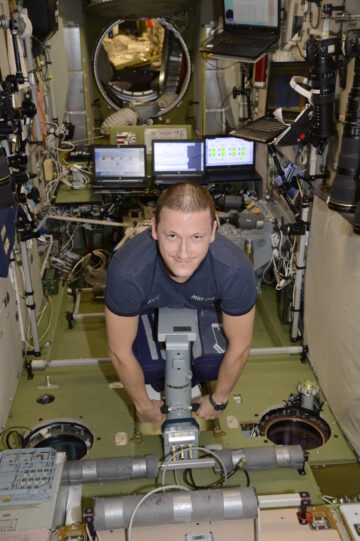
Roskosmos Cosmonaut Sergey Kud-carchkov performs periodic weighing of his body on the installation of the mass meter. Source: Roscosmos
Nervous system
In addition to the above disorders, a long stay in space may also lead to a violation of the functions of the immune system (reducing the level of B – and T-cells, anemia), respiratory tract, kidney (stones). Due to the failure of natural cycles of the day and night, a dream is disturbed, which can lead to serious neurological consequences in the future.
The impact of staying in space on the nervous system was studied during the STS-90 mission (NeuroLab) in 1998, during which cosmonauts studied the impact of weightlessness to the vestibular apparatus and the causes of adaptation syndrome.
Unforeseen cases
Modern cosmic medicine is primarily aimed at monitoring the symptoms described above in space and to develop drugs to prevent them on Earth. Nevertheless, in addition to listed factors, unforeseen circumstances and accidents on spacecraft are a serious threat to human health. According to statistics, during a 900-day flight to Mars on board the spacecraft, a minimum of one unforeseen case may occur, and modern space medicine must be ready for such situations. The priority problems in this area are anesthesia, operations, cardiovascular resuscitation, as well as drug delivery and their storage in space.
Denis Guriev, Head of the laboratory of radiation carcinogenesis and toxicology of the Federal State Unitary Enterprise of the SSC FMBC named after A. I. Burnazhan:
To assess the danger of cosmic radiation, it is necessary to understand its physical aspects. As a rule, radiation is formed by the solar protons of high energies, which have a wide range of linear energy transfer – the amount of ionization in the tissue per unit of run. So, the more slowly the particle is moving, the more the acts of ionization it produces per unit of run. The faster it moves – the less ionization. It turns out that the greater the particle energy, the less harm to health it carries. Therefore, when we are talking about cosmic radiation, it is important to understand that it is very dissimilar in physical characteristics: from the composition to energies.
In the outer space, the particle interacts not directly with the body, but with the cosmic vehicle. Vehicle cover multicompose. Particles of high energies interact with it, which leads to the formation of secondary radiation. As a result, avalanche of particles can be formed, which will be dangerous to the human body, because they have less energy, and the linear power transmission will increase.
Some options are considered, for example, modeling the magnetic shell on the spacecraft. According to estimates, installations with an energy of about 100 MW are required. The question is not yet resolved, since the installation must be compact, but quite powerful: then the particles will deviate, and the radiation effect will be significantly reduced.
The second aspect is the use of anti-columous agents. Studies are currently underway in this direction, and, unfortunately, drug-radio protector, which are used to reduce the harmful effects of radiation impact, as a rule, have a short period of action. The time of being in the conditions of radiation background with space flights is long, so their relevance disappears, and it is necessary to use preparations of a longer exposure.
According to the principle of action, drugs have a wide variety, starting from a decrease in hypoxic shock, that is, reduced oxygen levels in cells, since the active forms of oxygen generated by irradiation form a pool dangerous for DNA molecules. Other preparations reduce the concentration of free radicals in the cell. A number of drugs increase the intensity of reparation processes or change the structure of chromatin so that the reparation passed more successfully.
Cosmos storage in space is a serious problem due to instability and decay of their some components. For example, scientists from the Medical College of Beilora in the city of Houston, Texas, it was shown that the active component of acetaminophen, which is part of the well-known medicine theraflu and paracetamol tablets, in space and on Earth has different stability. Paracetamol in the teraflu was less stable in space, which significantly reduced its shelf life. Long storage of paracetamol in space led to the accumulation of harmful metabolites, capable of adversely affect human health. Since the release of new drugs takes into account only the conditions for storing and use on Earth, at the moment NASA and Bailor are carried out joint studies of the stability of various drugs in cosmic conditions.
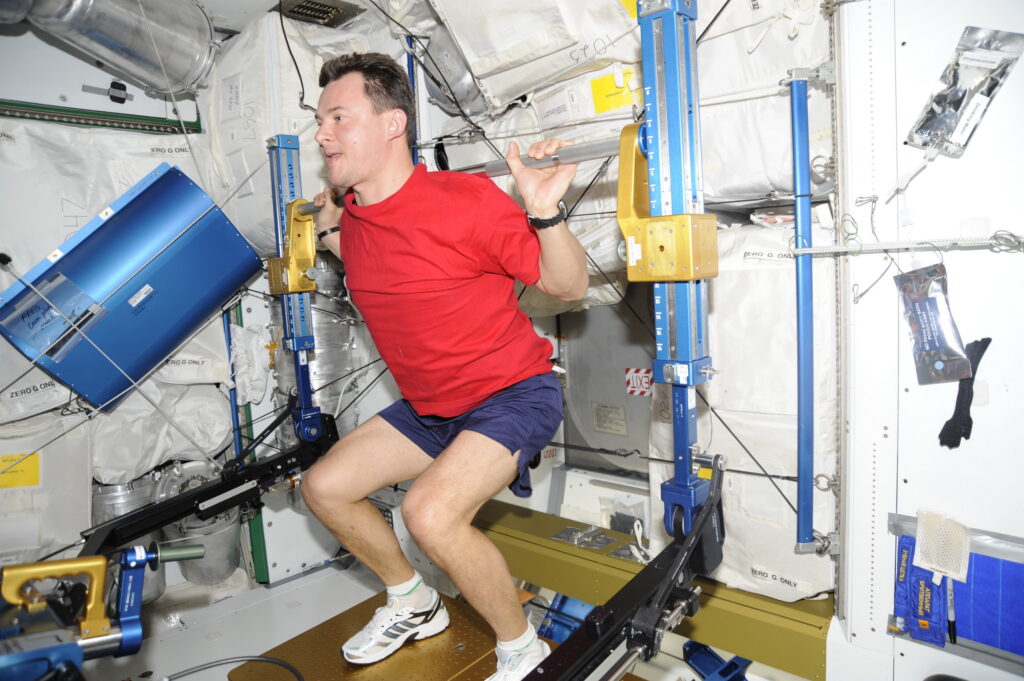
Cosmonaut Roman Romanenko Classes on the power simulator. Source: Roscosmos
In addition, due to the problem of the instability of gases in conditions of weightlessness and unforeseen effects on the cardiovascular system, with animal experiments, they managed to be anesthesia in space only intravenously, and only after several unsuccessful attempts.
Surgical operations in space also associated with considerable difficulties, especially under weightlessness. A number of experiments on the simulation of operations in space under gravity (in particular, the Baylor College of Medicine program with NVIDIA) is being conducted. Different types of urgent resuscitation devices in space also exist and adapted to gravity conditions. However, even if the resuscitation is possible to implement, the equipment has not yet been developed for long-term maintenance of life in space before returning to Earth.
It is foreseen
Finally, the most serious threat to the health of the cosmonauts is depressurization, fire and emissions of toxic waste during the flight. Even if for astronauts, additional oxygen cylinders and filters of smog and toxins are provided for a short time, the evacuation in such circumstances may be inevitable. Such actions should be coordinated by the Flight Control Center on Earth, doctors through telemedicine and can help astronauts and space tourists in unforeseen situations threatening their health during the flight.
If you have found an error, please select a text fragment and click Ctrl + Enter..
